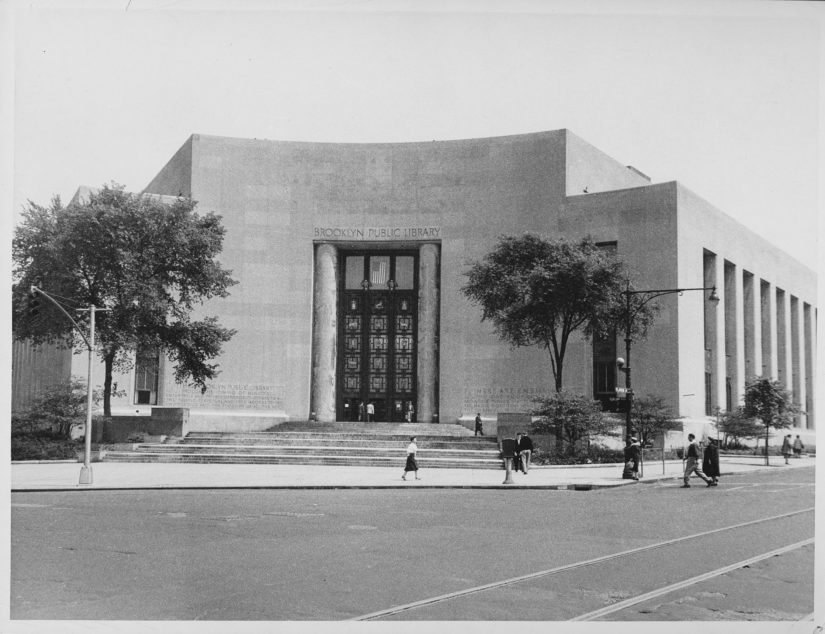
Francis Keally
Former president of the Municipal Art Society, Francis Keally advocated for the passage of the New York City Landmarks Law in the 1950s and 60s.
Francis Keally was born in Pittsburgh, Pennsylvania. He was educated at the Carnegie Institute of Technology and the University of Pennsylvania where he received his degree in architecture.1 Soon after graduating, he married Mildred Fessenden Taber in 1923.
Although Keally’s work is found in various parts of the world, he maintained ties in Pittsburgh producing a campus design plan with Alfred Morton Githens for the Carnegie Institute of Technology. Keally joined the American Institute of Architects in 1919 and obtained fellowship status in 1948.2 In 1954, he established an architecture firm with H. S. Patterson, a classmate at the University of Pennsylvania.
Some of his major architectural works include the Public Library in Berlin, Germany; the Brooklyn Public Library; the Oregon State Capitol; and the expansion of the Detroit Public Library.3
In addition to designing and constructing his own projects, Keally was an avid proponent of preserving the works of others. To further this goal, he served on the boards of several organizations dedicated to historic preservation. He served as president of the Municipal Art Society, as well as president of the Fine Arts Federation.4
Francis Keally passed away in 1978.
President, Municipal Art Society
President, Fine Arts Federation of New York
President, New York Chapter of the American Institute of Architects
Member, Committee for Modern Zoning
Keally was active in the mid-twentieth-century push to pass a landmarks law in New York City. As president of the Municipal Art Society, he began calling for a means to preserve historic buildings. In March of 1950, Keally went public with the Municipal Art Society's call for a landmarks law.5 In his early moves for a law he set four categories of buildings that should be preserved: “outstanding works of art; those possessing outstanding characteristics of the age in which they were built; structures whose attributes give a depth of times in an otherwise modern atmosphere; and buildings that were scenes of important events."6
Throughout the 1950s, Keally continued to voice his concern about the City's historic structures through numerous letters to The New York Times. He wrote of his concerns stating:
"there are certain buildings that must never receive the fatal blow of the bulldozer and the iron ball, if we are to pass on to our children...a heritage worthy of the name."7
Also during this time, he was a member of the Committee for Zoning. In that position, he advocated for the 1961 Zoning Resolution.8 This resolution changed the emphasis of the City’s urban renewal plans from demolition to preservation and rehabilitation.9
Keally continued his advocacy into the 1960s until the New York City Landmarks Law was passed. In July of 1965, The New York Times published a letter Keally wrote to the editor. In the letter, Keally calls for better funding for public projects in New York City. He argues that more aesthetically-pleasing architecture can only stem from capable architects that require better pay; leading to better preservation of New York edifices.10 Keally said of his purpose:
"Effective and uncompromising steps must be taken to save from destruction or obsolescence the few remaining historic landmarks that are meaningful reminders of early New York."11
- The Architectural Archives of the University of Pennsylvania preserves the works of hundreds of architects and designers from the 1800s to the present, including works of Francis Keally.
Architectural Archives of the University of Pennsylvania
Kroiz Gallery of the Architectural Archives
Lower Level of the Fisher Fine Arts Library
220 South 34th Street
Philadelphia, PA 19104 - Tel: (215) 898-8323
The University of Oregon collection includes drawings, correspondence, building specifications, photographs, publications, and other miscellaneous materials relating to the design and construction of the Oregon State capitol in Salem, Oregon (one of Keally's works). - University of Oregon Libraries
Special Collections & University Archives
1299 University of Oregon
Eugene, OR 97403-1299
Tel: (541) 346-3068
- ”Heads New York Chapter of American Architects,” The New York Times, 15 June 1951.
- Sandra L. Tatman, “Keally, Francis (1889-1978): Architect: Biography,” Philadelphia Architects and Buildings. Article retrieved 5 March 2016
- David B. Dearinger, ed., Paintings and Sculpture in the Collection of the National Academy of Design (Manchester: Hudson Hills Press LLC, 2004).
- Anthony C. Wood, Preserving New York: Winning the Right to Protect a City’s Landmarks (New York: Routledge, 2008), pages 286-287.
- “Law Urged to Save Landmarks of City,” The New York Times, 8 March 1950.
- Ibid.
- Francis Keally, “Letters to the Times: Preserving Landmarks,” The New York Times, 16 December 1960.
- Francis Keally, “Letters to the Times: Zoning Plan Backed,” The New York Times, 30 December 1959.
- Anthony C. Wood, Preserving New York: Winning the Right to Protect a City’s Landmarks (New York: Routledge, 2008), page .
- Francis Keally, “Backs Move to Adorn City’s New Structures,” The New York Times, 7 August 1965, page 20.
- Francis Keally, “Letters to the Times: Saving City’s Landmarks,” The New York Times, 4 October 1961.




